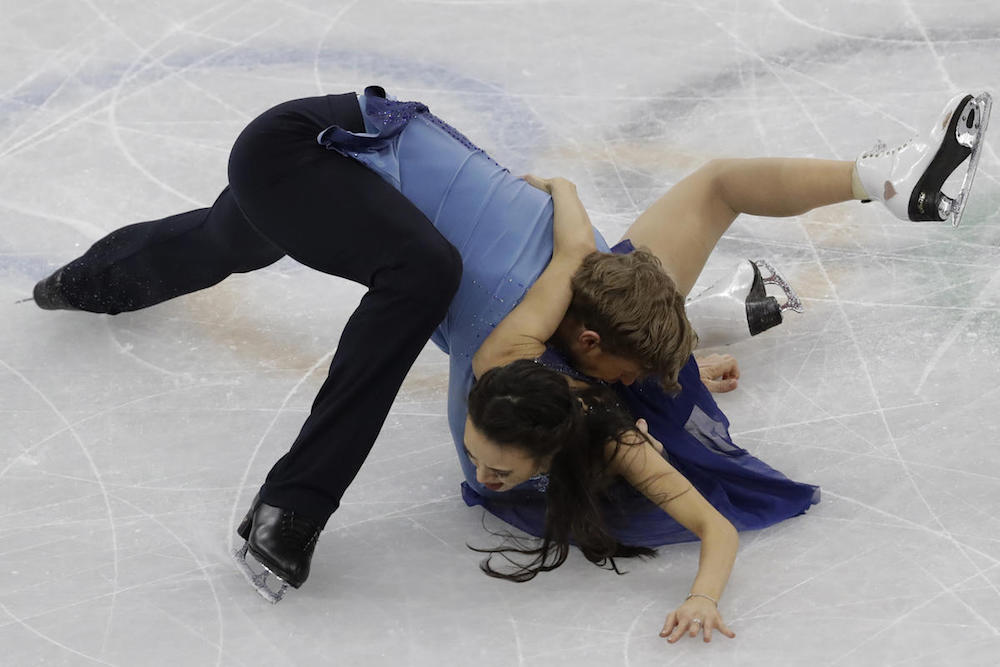
Madison Chock and Evan Bates at the PyeongChang 2018 Olympic Winter Games. Photo by Bernat Armangue.
On February 19, when the American pair Madison Chock and Evan Bates glided onto the ice for the free-dance competition at the Winter Olympics in Pyenogchang, some Darwinian instinct in me whispered, Root for them. You won’t be disappointed. They were calm, focused, attractive. My faith was shaken for a moment when their risky music choice began playing—a cover of John Lennon’s “Imagine,” sung live from inside the arena. But when Chock and Bates met eyes and began their routine, their synchronicity had a strange, tranquil power. A hush descended on my friend’s living room. Watching TV felt like being in nature.
Their dreamy routine evoked stillness with motion, and their movements were so linked that it felt as if their individual personalities converged into one. I couldn’t tell the ice dancers from the ice dance.
A few minutes in, they tangled blades and Bates went down like a teen at Chelsea Piers. The pathos of the moment was intense—years of work and hope vanished in an instant. In addition to their deduction, they got no points for that combination spin. They were hemorrhaging points.
In terms of demeanor and tone, Chock and Bates aced what many others flubbed. Their performance felt unforced, intimate—a feat, when you consider they were dressed in rhinestones, performing in a rink just forty miles south of the North Korean border as millions watched and judged.
Contrast Chock and Bates with Ekaterina Bobrova and Dmitri Soloviev, who didn’t fall but who never let their audience forget that they were putting on a show; they seemed to have choreographed even their post-performance celebrations, slapping the ice and hugging on cue. They came in fourth, five places ahead of Chock and Bates.
Judges favor technical flawlessness over uneven performances with moments of transcendence. There are only three subcategories of scoring (performance, composition, and interpretation of music/timing) in which artistry is taken into account. As such, artistic pathos can impact, at most, only a small portion of the final score. The rest depends on whether or not they performed the required elements, and how well those elements were executed.
Judges are high-pressure performers themselves. They aspire to aesthetic agnosticism, but their subjective assessments of artistry inevitably garner blowback. The National Figure Skating Association, which arbitrates the appointment of judges in the U.S., requires that prospective judges maintain “the ability to handle stress … after being challenged or ridiculed for a mark or placement.” A common point of ridicule is that the judges are biased, and the stress appears to come from the fact that the charge is true. Figure skating judges are appointed by national federations rather than an international committee, which means they often judge their own country’s athletes, and have been shown to pick favorites. In the words of the Dartmouth economist Eric Zitzewitz, “The Olympics might be the most biased of all international skating competitions.” But unless a judge makes some Papadopoulos-style drunken confession, how can one discern whether the consistent boosting of her own country’s skaters means a judge is engaged in a conscious conspiracy, or whether she is just earnestly prefers the cultural sensibility she’s imbibed at home?
This is maybe the aspect of judging a multicultural artistic sport competition that one would envy least. Sports like ice dancing aren’t just contests between athletes representing countries, they’re also contests between the cultural aesthetics of the countries in competition. Sometimes it’s explicit. The Italians Anna Cappellini and Luca Lanotte, for example, danced to a song from the Life Is Beautiful soundtrack, “La vita é bella”—Cappellini in a red dress, and Lanotte in a cream-colored 1940s shirt, with brown trousers and suspenders. Japan’s Kana Muramoto and Chris Reed danced to Ryuichi Sakamoto, their clothes and choreography intended to evoke cherry blossoms. The judges aim to assess style divorced from substance, but the history of Olympic judging in skating has been rife with bias and scandals—a culture of favoritism that prompted the International Skating Union to change their scoring system in 2002 when the pairs figure-skating competition was revealed to be fixed.
If you watch an ice dance performance as both a sports competition and as a televised art show, the emotion of the performance means as much or more than technical perfection. Tragic as they are, falls reveal character. Janet Lynn had a beautiful, inspiring fall in the 1972 Olympics in Sapporo. She stood up smiling—genuinely—and then continued on, snapping back into virtuosity. Shae-Lynn Bourne and Victor Kraatz both tumbled down onto the ice in Salt Lake City in 2002. They lied there for a moment, panting and smiling, because there was nothing else to do. Then Bourne leaned over and kissed Kraatz on the lips. Despite their momentary inelegance, Chock and Bates gave a moving, magical performance at the 2018 Olympics. You may say I’m a dreamer, but I’m not the only one.
from The Paris Review http://ift.tt/2oLPijf
Comments
Post a Comment